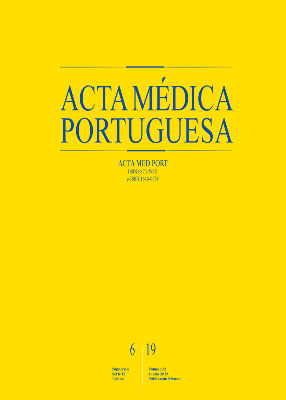Um Caso Raro de Radiculopatia: Displasia Fibrosa Monostótica do Sacro
DOI:
https://doi.org/10.20344/amp.9331Palavras-chave:
Displasia Fibrosa Monostótica, Radiculopatia, SacroResumo
A displasia fibrosa é uma doença óssea caracterizada por uma disfunção osteoblástica que resulta na substituição do osso medular normal por tecido fibroso. Descrevemos o caso de uma doente de 33 anos que se apresentou com lombalgia e ciatalgia direita. A tomografia computorizada e ressonância magnética lombares revelaram uma lesão osteolítica e multiquística no hemissacro direito com invasão do foramen de S1. A doente foi submetida a foraminotomia e curetagem da lesão. O diagnóstico histológico foi de displasia fibrosa, sem sinais de transformação maligna. Três anos após a cirurgia, a doente está assintomática e os estudos de imagem apresentam estabilidade da lesão. Este é o quinto caso conhecido na literatura de displasia fibrosa monostótica com atingimento do sacro, uma entidade rara que deve ser considerada no diagnóstico diferencial de doentes com lesões do sacro.
Downloads
Downloads
Publicado
Como Citar
Edição
Secção
Licença
Todos os artigos publicados na AMP são de acesso aberto e cumprem os requisitos das agências de financiamento ou instituições académicas. Relativamente à utilização por terceiros a AMP rege-se pelos termos da licença Creative Commons ‘Atribuição – Uso Não-Comercial – (CC-BY-NC)’.
É da responsabilidade do autor obter permissão para reproduzir figuras, tabelas, etc., de outras publicações. Após a aceitação de um artigo, os autores serão convidados a preencher uma “Declaração de Responsabilidade Autoral e Partilha de Direitos de Autor “(http://www.actamedicaportuguesa.com/info/AMP-NormasPublicacao.pdf) e a “Declaração de Potenciais Conflitos de Interesse” (http://www.icmje.org/conflicts-of-interest) do ICMJE. Será enviado um e-mail ao autor correspondente, confirmando a receção do manuscrito.
Após a publicação, os autores ficam autorizados a disponibilizar os seus artigos em repositórios das suas instituições de origem, desde que mencionem sempre onde foram publicados e de acordo com a licença Creative Commons









